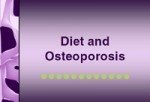Osteoporosis and Cholesterol
 Growing scientific evidence suggests that the same type of diet that promotes atherosclerosis (hardening of the arteries) may also promote osteoporosis. When most people think of high LDL (“bad” cholesterol) levels in the blood, they associate it with clogged arteries and an increased risk of cardiovascular disease. However, research is now indicating that higher levels of LDL in the blood may not only lead to blocked and calcified arteries but also thinned and decalcified bones. If this theory proves correct, then the reason that a diet high in animal products promotes osteoporosis may have more to do with their fat and cholesterol content than their protein content.How could high LDL contribute to osteoporosis? Just as LDL particles can move from the blood and into arteries, they can also enter bones. In the artery wall, these white blood cells (called monocytes) turn into macrophages that engulf modified LDL particles and turn into “foam” cells. The accumulation of these cells leads to atherosclerotic plaque.In the bone, increased LDL can also attract more monocytes, which turn into osteoclasts. Osteoclasts eat away surrounding bone structure like miniature Pacmen. When LDL levels are in the healthy range (50-100mg/dl), the bone-eating activity of these macrophages is offset by another bone cell known as an osteoblast, which constantly builds up new bone tissue. As LDL levels rise in the blood and bone, the activity of osteoclast becomes greater. At the same time, oxidized LDL in the bone inhibits the formation of osteoblasts. As a result of increased LDL in the bone, overall bone mineral density declines. Over time, elevated LDL levels can contribute to the development of osteoporosis. Research has shown that drugs and diets that lower LDL can reduce the loss of bone in animals and/or human subjects.* The consumption of milk and dairy products may have both positive and negative effects on bone health. The very high saturated fat and cholesterol con- tent of full and even low-fat dairy products may raise LDL levels enough to offset the beneficial effects of the extra vitamin D and calcium they supply. Unless LDL are below 100 mg/dl, it seems wise to advise people at risk for either atherosclerosis or osteoporosis to limit all dietary sources of saturated and hydrogenated fat as well as cholesterol.* Parhami F, Garfinkel A, Demer LL. Arterioscler Thromb Vasc Biol 2000;2346-8By Dr. James J. Kenney PhD, RD, FACNBrought to you by the Nutrition Education Store. Want to learn more about the connections between diet and health? Check out our posters, handouts, presentations, books, recipe files, games, and more!
Growing scientific evidence suggests that the same type of diet that promotes atherosclerosis (hardening of the arteries) may also promote osteoporosis. When most people think of high LDL (“bad” cholesterol) levels in the blood, they associate it with clogged arteries and an increased risk of cardiovascular disease. However, research is now indicating that higher levels of LDL in the blood may not only lead to blocked and calcified arteries but also thinned and decalcified bones. If this theory proves correct, then the reason that a diet high in animal products promotes osteoporosis may have more to do with their fat and cholesterol content than their protein content.How could high LDL contribute to osteoporosis? Just as LDL particles can move from the blood and into arteries, they can also enter bones. In the artery wall, these white blood cells (called monocytes) turn into macrophages that engulf modified LDL particles and turn into “foam” cells. The accumulation of these cells leads to atherosclerotic plaque.In the bone, increased LDL can also attract more monocytes, which turn into osteoclasts. Osteoclasts eat away surrounding bone structure like miniature Pacmen. When LDL levels are in the healthy range (50-100mg/dl), the bone-eating activity of these macrophages is offset by another bone cell known as an osteoblast, which constantly builds up new bone tissue. As LDL levels rise in the blood and bone, the activity of osteoclast becomes greater. At the same time, oxidized LDL in the bone inhibits the formation of osteoblasts. As a result of increased LDL in the bone, overall bone mineral density declines. Over time, elevated LDL levels can contribute to the development of osteoporosis. Research has shown that drugs and diets that lower LDL can reduce the loss of bone in animals and/or human subjects.* The consumption of milk and dairy products may have both positive and negative effects on bone health. The very high saturated fat and cholesterol con- tent of full and even low-fat dairy products may raise LDL levels enough to offset the beneficial effects of the extra vitamin D and calcium they supply. Unless LDL are below 100 mg/dl, it seems wise to advise people at risk for either atherosclerosis or osteoporosis to limit all dietary sources of saturated and hydrogenated fat as well as cholesterol.* Parhami F, Garfinkel A, Demer LL. Arterioscler Thromb Vasc Biol 2000;2346-8By Dr. James J. Kenney PhD, RD, FACNBrought to you by the Nutrition Education Store. Want to learn more about the connections between diet and health? Check out our posters, handouts, presentations, books, recipe files, games, and more!


